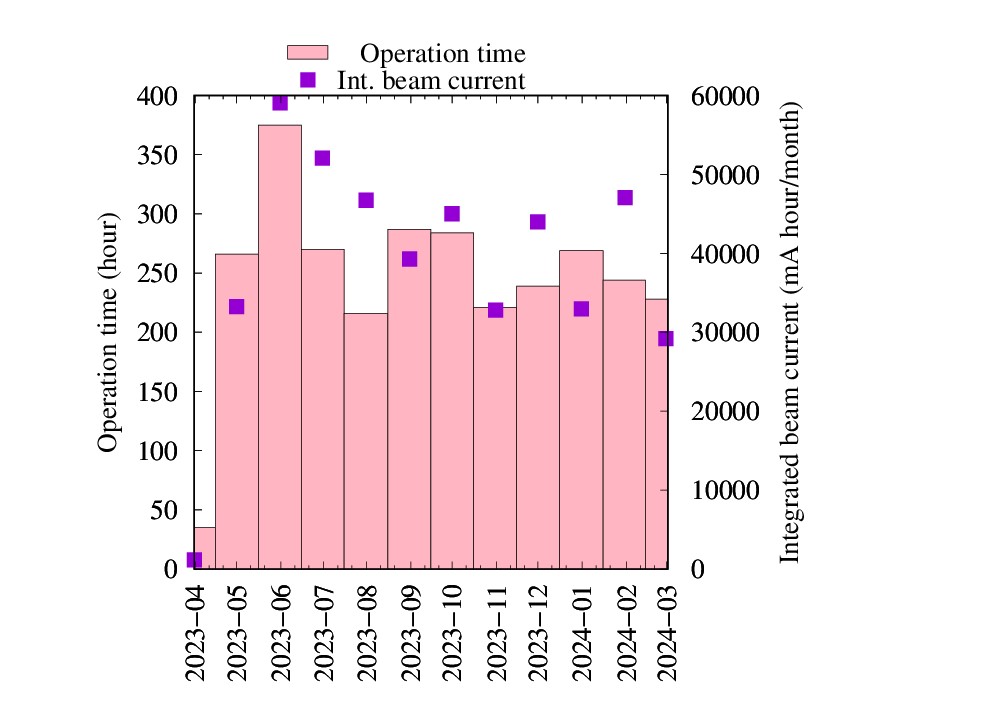光源の現状(2023年度)|Light Sources in 2023
2023年度は、UVSOR-IIIは予定通り、2023年5月末から2024年3月までの36週間、ユーザー運転を行いました。月別の運転時間と積算ビーム電流の統計を、図1に示します。4月初旬から5月初旬にかけては、定期点検が行われました。運転停止後の2週間は、加速器とビームラインの調整に充てられました。
週間運転スケジュールは以下の通りです。月曜日は朝9時から夜9時までマシンスタディに割り当てられています。ユーザー運転は火曜日から金曜日まで割り当てられており、火曜日と水曜日は朝9時から夜9時まで、木曜日は朝9時から金曜日の夜9時まで、36時間連続して運転されます。これにより、ユーザーのビームタイムは1週間あたり60時間となります。
7月~8月にかけて落雷による瞬時電圧低下が頻発し、ビームダンプが発生し運転時間が減少しました。シンクロトロン1次キッカー用パルス電源の高圧充電ケーブルの絶縁破壊が数回発生しましたが、ケーブルの交換により復旧しました。線型加速器用Sバンドパルス増幅器の故障が発生しましたが、増幅器のゲイン調整により対応しました。再発の懸念があるため、S-bandパルス増幅器の更新を検討しています。
電子ビーム蓄積リングへの入射効率は、2023年1月頃から低下し始めました。入射効率は、ブースターシンクロトロンと蓄積リング間の輸送ラインを通過する電流値の増加分Iを蓄積電流値で割った値として算出されます。通常運転時は、入射効率が60~70%、δIが0.4~0.6mA/shotでしたが、2023年1月以降は、入射効率が20~30%、δIが0.1~0.3mA/shotに低下しました。蓄積リングに1週間あたりに入射できる電子数が限られているため、300mA運転を継続することが困難になってしまいました。そのため、2023年5月より蓄積電流値を200mAに落としてユーザー運転を実施しています。原因究明のため、さまざまな調査を続けていますが、今のところ明確な原因は特定できていません。しかし、ブースターシンクロトロンから取り出される電子ビームの品質が劣化していることは確認されていまず。ブースターシンクロトロンの偏向電磁石部にある真空ダクトはたびたび真空漏れが起きていますが、調査のため大気解法を行うことで真空漏れの状況を悪化させてしまう懸念があり、真空ダクト内部を目視で確認することができていません。偏向電磁石部にあるすべての真空ダクトは、2025年春に新しいものに交換される予定です。その際に、ブースターシンクロトロン部の真空ダクト内部にビームを散乱させる異物があったのかどうか確認を行う予定です。
将来のUVSOR-IV建設に向けての設計研究を開始しました。第一段階として、現状の磁石配置を解析し、エミッタンスをさらに低減できる可能性を検討しました[1]。劇的にエミッタンスを低減できるような解決策は見つかりませんでしたが、エミッタンスの低減に寄与し得る興味深い解決策をいくつか見つけることができました。第二段階として、VUV領域で回折限界に近い性能を持つ全く新しい蓄積リングの設計を開始しました[2]。
文部科学省・科学技術振興機構(JST)の「量子ビームテクノロジープログラム」の支援を受けて建設された光源開発と利用ビームラインBL1Uでは、自由電子レーザー、コヒーレント高調波発生、コヒーレント放射光、コヒーレント制御[3]、レーザーコンプトン散乱ガンマ線[4, 5]、光渦[6]などの新しい光源技術とその応用を開発し続けています。
In FY2023, UVSOR-III was operated for users as scheduled for 36 weeks from end of May 2023 to March 2024. Monthly statistics of operation time and integrated beam current are shown in Fig. 1. From the beginning of April to early May, during which periodic inspections were conducted. The two weeks following the shutdown were allocated to the adjustment of the accelerator and beamlines. The weekly operation schedule is as follows. Mondays are assigned to machine studies from 9:00 AM to 9:00 PM. User operation is assigned Tuesday through Friday, with Tuesday and Wednesday operating from 9:00 AM to 9:00 PM, and Thursday from 9:00 AM to 9:00 PM on Friday for 36 continuous hours. Thus, the user's beam time per week is 60 hours. Instantaneous voltage drops due to lightning strikes occurred frequently during the July-August period. This caused beam dumps, leading to loss of operation time. Several insulation breakdowns of the high-voltage charging cable of the pulse power supply for the synchrotron first kicker have occurred, but have been restored by replacing the cable. A malfunction of the S-band pulse amplifier for the linear accelerator occurred, but has been addressed by adjusting the amplifier gain. We are considering updating the S-band pulse amplifier due to concerns that the problem may recur. Injection efficiency of the electron beam into the storage ring started to decrease around January 2023. The injection efficiency is calculated as the ratio of the increase in the stored current value, I, to the current value passing through the transport line between the booster synchrotron and the storage ring. Under normal conditions, the injection efficiency was 60~70% and I was 0.4~0.6 mA/shot, but after January 2023, the efficiency dropped to 20~30% and I 0.1~0.3 mA/shot. The limited number of electrons that can be injected into the storage ring per week makes it difficult to continue 300 mA operation. Therefore, user operation has been conducted with the stored current value reduced to 200 mA since May 2023. Various investigations are continuing to determine the cause, but so far no clear cause has been identified. However, it has been confirmed that the quality of the electron beam extracted by the booster synchrotron has deteriorated. The vacuum ducts in the bending magnet section of the booster synchrotron have experienced multiple vacuum leaks, and there is concern that opening the ducts to the atmosphere may induce serious vacuum leaks, so it is currently impossible to visually check inside the ducts. All vacuum ducts in the bending magnet section are scheduled to be replaced with new ones in the spring of 2025. At that time, we will check the inside of the vacuum ducts of the booster synchrotron to see if there are any foreign objects that are scattering the beam. We started a design study for the future plan of UVSOR-IV. As a first step, we have analyzed the present magnetic lattice, seeking a possibility to reduce the emittance more [1]. Although, we did not find a solution to drastically reduce emittance, we have found a few interesting solutions that achieved lower emittance than the current situation. As the second step, we have started designing a totally new storage ring, which is close to the diffraction limit in the VUV range [2]. The light source development and utilization beamline BL1U, constructed under the support of Quantum Beam Technology Program by MEXT/JST, continue to develop new light source technologies and their applications such as free electron laser, coherent harmonic generation, coherent synchrotron radiation, coherent control [3], laser Compton scattered gamma rays [4, 5], and optical vortices [6].

Fig. 1. Monthly statistics in FY2023.
Yoshitaka TAIRA (UVSOR Synchrotron Facility, Institute for Molecular Science)



